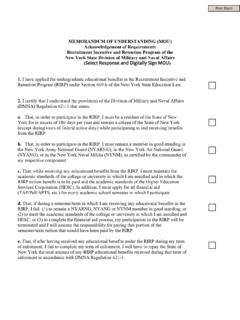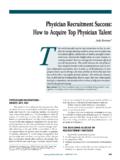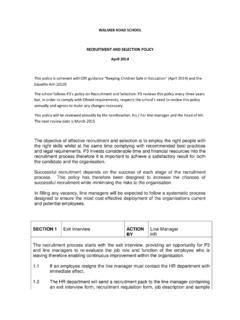Transcription of Recruitment and Retention Guide for Small Rural Hospitals
1 Recruitment and Retention Guide for Small Rural Hospitals Developed for the Technical Assistance Service Center by THE NATIONAL Rural Recruitment AND Retention NETWORK, INC 1 TASC Technical Assistance and Service Center _____ This is a publication of the Technical Assistance Service Center for Critical Access Hospitals . For questions, concerns, clarification, or technical assistance, contact: TASC 600 E Superior St, Suite 405 Duluth, MN 55802 Phone: 218-720-0700 Toll Free Phone: 877-321-9393 Fax: 218-727-9392 2 Recruitment and Retention Guide for Small Hospitals Table of Contents Page Number Part One: Planning and Preparation 3 Step 1: Assess Need for Primary Care Providers 4 HPSA Benefits 4 Step 2: Gain Support for the Recruitment Effort 10 Step 3: Form a Recruitment Team 12 Step 4: Define Your Opportunity 17 Benefits Value 20 Step 5: Define the Ideal Candidate 25 Step 6: Develop a Recruitment Budget 26 Recruitment / Retention Barriers 31 Part Two: Searching for Candidates 32 Step 7: Generate Candidates 32 Is Rural Living For You?
2 36 Part Three: Screening Candidates 38 Step 8: Interview Candidates 40 Step 9: Conduct Credential Checks 43 Step 10: Interview the Spouse 45 Step 11: Check References 47 Step 12: Conduct a Site Visit 49 Common Site Visit Issues 51 Part Four: Follow Up and Follow Through 53 Step 13: Follow-up Letter 53 Step 14: Follow-up Negotiations 53 Step 15: Develop and Implement a Retention Plan 55 Retention Questionnaire 56 3 Keys to Successful Recruitment Preparation Action Pan (with assignments and deadlines) Continuity of Effort: Persistence Adequate Recruitment Budget: Process and Compensation Community and Medical Staff Support and Involvement Adequate Human Resources Enough of the Right People Optimism Realistic Expectations Time, Competition PartOne Planning and Preparation is the most important ingredient for ensuring a successful Recruitment effort.
3 It is also the part most often neglected. Many Hospitals and communities jump into the Recruitment process with little preparation. Often this results from surprise at the sudden loss of a primary care provider. Hospitals that jump into Recruitment typically spend more money and time on Recruitment and enjoy less Retention success than those that prepare and systematically search for the right candidate. In addition, surprise at the loss of a provider often indicates a lack of active Retention building efforts. A warning signal suggesting lack of preparation for Recruitment happens when the first step to replace a provider is placing an advertisement in a national journal or hiring a Recruitment firm. This strategy is usually expensive and often ineffective. The following six steps in planning and preparing for Recruitment will help you avoid surprises and conduct a search that is less costly and more effective: Step 1: Assess your need for a primary care provider: physician, physician assistant or nurse practitioner.
4 Step 2: Gain support for recruiting another primary care provider. Step 3: Form a community-based Recruitment team and make assignments. Step 4: Define your practice opportunity. Step 5: Define the ideal candidate for your hospital and community. Step 6: Develop a Recruitment budget. planning and preparation 4 Typical Reasons for Recruiting a Primary Care Provider The local population has grown significantly during the last few years, or rapid growth is forecasted. The current primary care providers are overworked, and their practice loads are at a maximum capacity. One or more of the providers are nearing retirement. The loss of a provider due to relocation, death or disability. One or more providers are scaling down his/her practice in terms of clinic hours, patient load or scope of services. step Before you place the doc wanted ad, be sure you know whether or not you even need another doc.
5 Even though you may perceive a provider shortage in your community, spend some time considering why and if you need to recruit a physician. You may find that a nurse practitioner or physician assistant is more appropriate or that local demand for primary care does not justify recruiting a new provider at all. Once you have assessed why you may need to recruit, determine if you need another primary care provider. Determining the number of primary care providers required to serve a given population can be a complicated process. The most common methods used to measure primary care provider need are the simplest. These methods compare the number of people living in a given service area to the number of primary care providers serving that area. While these methods, which include the federal Health Professional Shortage Area (HPSA) designation process, can provide you a general indication of need, they could be misleading, for simple head counts fail to take into account primary care utilization rates of different population groups within the service area.
6 For example, Community A, Elderville, and Community B, Nuggett, both have a population of 3,500 residents. But Elderville is a popular retirement community, while Nuggett is a gold mining boom town. Consequently, one community is largely inhabited by seniors while the other is inhabited mostly by men between the ages of 18-45. Which town will use primary care providers more? Which town do you think actually needs more primary care providers? While this example may be extreme, it does demonstrate the major pitfall of determining need based solely on the size of your population. An easy way to go beyond head count methods is called the Demand-Based Needs Assessment. This assessment accounts for both the size and demographic make-up of your service area population. The Demand-based Needs Assessment uses the health and lifestyle of a given population to provide insight into local demand for primary care services.
7 Research shows us that men and women of different age groups use medical services at quite disparate levels. We define these sex-age groups by lifecycles: prenatal, pediatric, adolescent, adult and geriatric. 1 assess need for primary care providers 5 The size of your population and the proportion in each lifecycle group will determine how many patient visits local residents will make to a primary care provider during a given year. The number of primary care patient visits generated by your service area population is called demand. Understanding your community s demand for primary care enables you not only to determine how many primary care providers your community needs but also to project: How the providers will be utilized ( service demand by patient type: geriatric, pediatric, obstetrics/gynecology, etc.); The number of primary care providers your community can financially support; and To a degree, the impact the provider will have on hospital utilization and revenues.
8 How to Conduct a Demand-Based Needs Assessment A. Define Your Service Area B. Calculate Primary Care Provider Supply C. Calculate Primary Care Demand D. Measure Supply versus Demand Defining Your Service Area What population will the new primary care provider serve? Local Recruitment teams often define their service area population by city limits or county lines. Be aware that such boundaries are geo-political divisions and usually are not sensitive to actual consumer flow patterns. Think of the last time you factored in the county line when deciding where to have your car serviced. The same holds true for health care services. A more accurate yet relatively simple way to determine your service area is to find out where most of the local primary care providers and hospital s patients live by zip codes. Provider offices and Hospitals that store patient records electronically can often determine local patient origin using zip codes in a matter of minutes, without compromising confidentiality.
9 The process is obviously more arduous and time consuming when patient records are only kept in written documents. If you can access computerized patient origin records, gather patient data by zip code, age, sex, payor source (insurance company) and diagnosis. This will help you fully define your service area by geography and demography (population sub groups). Once you have defined your service area, obtain census breakdown information by age and sex for all residents in your service area. This information is typically available through state commerce departments or through vital statistic/health departments. Request the information for each zip code in your service area. Collecting census information by zip code is most practical because zip code boundaries follow logical transportation systems and represent sub-county areas. 6 Lose a Primary Care Physician? You may benefit from your loss.
10 You could qualify for Health Professional Shortage Area (HPSA) designation status through the federal government and be eligible to participate in a variety of federal programs, including: Incentive Payment for Physician s Services Furnished in HPSAs gives 10 percent bonus payment to physician s providing Medicare-reimbursable services in geographic HPSAs. Higher Customary Charges for New Physicians in HPSA exempts new physicians opening practices in non-metropolitan geographic HPSAs from new Medicare limitations on customary charges . Rural Health Clinics Act provides Medicare and Medicaid reimbursement for services provided by physician assistants and nurse practitioners in clinics in Rural HPSAs. National Health Service Corps (NHSC) provides assignments of federally employed and/or approved physicians, dentists and other health professionals to designated HPSAs. National Health Service Corps Scholarship Program provides scholarships for training of health professionals, including primary care physicians, who agree to serve in designated HPSAs.





